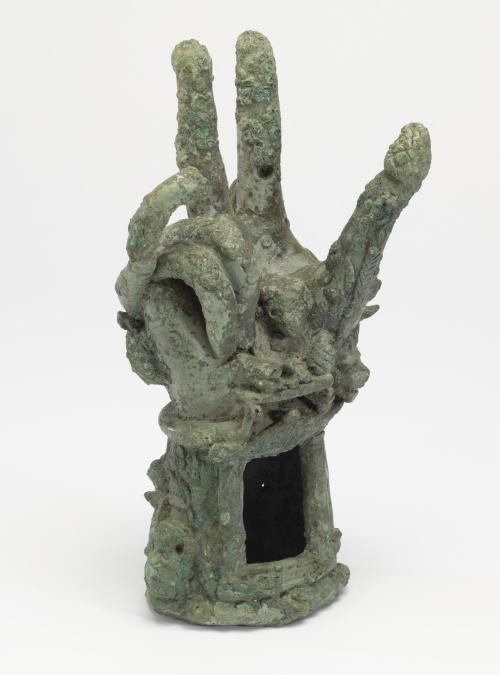#dying gods
Roman Hand of Sabazius, 3rd century, made of bronze.
Courtesy & currently located at the Walters Art Museum, USA:
Many religions were syncretistic, meaning that as they grew and came into contact with other religions, they adopted new beliefs and modified their practices to reflect their changing environment. Both Greek and Roman religious beliefs were deeply influenced by the so-called mystery religions of the East, including the Egyptian cult of Isis, which revealed beliefs and practices to the initiated that remained unexplained, or mysterious, to the uninitiated.
Most popular Roman cults had associations with these mystery religions and included the prospect of an afterlife. Sabazius was an eastern god of fertility and vegetation, who in Roman times was worshiped in association with other deities, particularly Dionysus (or Bacchus, as he was generally known to the Romans). His cult inspired a series of votive images of hands, the fingers of which form the gesture of benediction still familiar in Christian practice.
Missing from this example is the small figure of Sabazius himself, who was typically seated in the palm of the hand above the ram’s head. Around him are his major cult symbols, including a snake, a lizard, and the heads of a lion, a ram, and a bull. On the tip of the thumb is the pinecone of Dionysus. The opening in the wrist, shaped like a temple, had a hinged door that revealed an unknown, lost object, perhaps a reclining mother and child, as seen in other examples.
Post link
The son of God conceived immaculately and born on December 25, his fate, to triumph over death. Sound familiar? A clue: it’s not Jesus.
The deity in question above was Mithras, who for centuries had been one of the most popular deities in the world, favored by soldiers and sailors his cult found its way to the common people in distant corners of the Empire.
“dying gods” were all the rage in late antiquity, and when the Roman empire sought to consolidate its many cults into a state religion (what would become institutional Christianity) they took a ‘fusion’ approach.
Religion seems to continuously combine the new with the old, even for all its usual claims to immutable and eternal truth. Just as the figure of Christ coalesced out of an environment of religious diversity, a millennium and a half prior the figure of Yahweh can be found coming to prominence from an obscure position in the polytheism of Ugarit (Bronze Age Canaan) - but that’s a story for another time.
Here I will post some images of Mithras 'lord of the universe,’ surrounded by the zodiac and 4 quadrant figures akin to the iconic evangelists, as well as the same scene rendering Jesus in Mithras’ place. The images, separated in their creation by centuries, tell of a transition but also of a persistence of a certain archetype. As a motif, this can be said to have emerged out of antiquity but to have persisted since thanks to Christendom.





